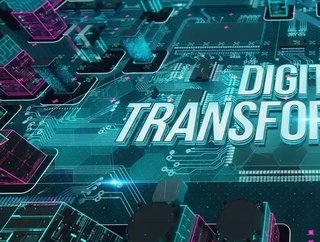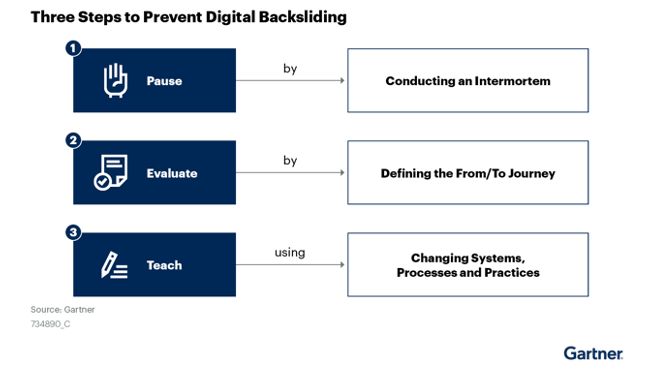Sustaining the fast pace of digital business transformation

The acceleration of digital business initiatives triggered changes in the way work gets done and decisions are made, but as hybrid workforce models continue, leaders are finding it critical to keep up digital momentum.
That means ensuring that non-digital behaviours and practices don’t creep back into processes and decisions that were transformed during the pandemic response.
Most leaders have a list of their team’s amazing accomplishments as part of the pandemic response. It feels as though organisations can keep the momentum going and escalate the digital plans they have been strategising for way too long all these years.
But — and, yes, there is a “but” — as organisations work toward their own instantiation of hybrid working that makes sense for them, there may be a return to behaviours that are not consistent with the digital plans. Psychologists highlight that, during the pandemic, people are feeling nostalgia for the past and that “the past has never looked so good.” As team members head back into the office, they will feel a desire to return to the “good old days.” But many of those old ways of working are not what organisations want, moving forward. Organisations need to prevent digital backsliding.

Pause, discuss and document progress made on digital plans
Stop and assess how the organisation is doing by conducting an intermortem, a mid-transformation assessment during which leaders gather insights from team members and peers and evaluate performance data. Similar to the postmortem exercise teams conduct at the end of a project to capture lessons and best practices, intermortems occur at an inflection point mid-transformation instead of at the end.
The way that work is getting done should be categorised by the source and the type of shift of the activity or behaviour. Looking at the source of the activity and what drove it we find there are three main categories: Strategy — is what we’re doing still focuses on the strategy of the enterprise primarily or have we veered off course; Cost-efficiency — is what we’re doing adding or relieving cost pressures; and productivity — are we improving or inhibiting employee productivity.
Once we’ve identified what we’re doing and its effect on the organisation, we leaders can then choose the type of shift they need to make. There are three shifts you can make: Retain — keep the changes that happened because of the crisis that you’ve found are an improvement of past processes; Reinvent — do this differently, because while the changes are good, they aren’t great and need some continued effort; or return — revert to previous, because what was being done previously is best.
Pausing quick tips include:
- Involve stakeholders from across the organisation
- Assess practices for sustainability. For example, employees working more hours from home than they did at the office is not a sustainable business model and shouldn’t stay in the “retain” pile even though productivity has increased.
Evaluate what adjustments maintain or accelerate digital plans
Once you have identified which behaviours you want to retain, reinvent or return, evaluate the systems and technology that are in place to see whether they support those desired behaviours or discourage outdated ones. This will be one of the themes featured at the upcoming IT Symposium/Xpo.
If your organisation needs to change systems, processes or practices, develop a plan to design, develop and implement them. Justify these changes by documenting what you have now (from), what you want to replace it with (to) and what the change will accomplish (because).
For example, organisations have learned that employees can be just as productive from home as in the office, leading many to consider recruiting people who live far from the organisation’s physical offices as a way to address talent shortages.
Recruiting, hiring and onboarding remote employees requires investments in geographic outreach, video interview processes, remote onboarding assets, and so on. The “evaluate” step in this case would involve documenting and justifying the changes the organisation needs to make from on-site hiring of local talent to remote hiring of non-local talent, because the organisation can access a deeper pool of talent.
Evaluation quick tips include:
- Prioritise between one and three practices highlighted in the intermortem template
- Identify the changes that need to be made, why and how the business will benefit for each priority change
Teach the organisation what needs to be done differently
You have identified the actions that need to be taken to reinforce the behaviour changes that you identified in the intermortem. Now, you need to create action plans. The action plans will spell out who needs to do what, by when. This is where the real work gets done. When leaders say that change is hard, this is where the hard part lies. Change is not hard — it is just tedious, and people lose patience with the constant focus.
Once you develop your plans, work the plan, and follow up regularly with your team and business partners to make sure that real change is happening. Depending on the complexity of the changes that you are trying to implement, consider revisiting your plans in three to six months’ time.
Teaching quick tips include:
- Socialise this plan with all affected stakeholders, and have regular meetings to assess progress, remove roadblocks, provide feedback or redefine timelines
- Assign responsibility with clear expectations to ensure the changes are made.
When you are on a roller coaster, it can be fun to slide backward. But when you are under pressure from your leadership to continue accelerating digital plans, backsliding is definitely not desired. You must design the change you need to see in your organisation. You can do so by pausing to reflect on how things are working now, evaluating what needs to change, and shaping the behaviours by creating and implementing your action plans.
- Five Minutes With: Sarah Robb O'Hagan, CEO at ExosLeadership & Strategy
- Liz Elting – Driving Equality & Building Billion-$ BusinessLeadership & Strategy
- Five Minutes With: Kelly Ahuja, CEO at Versa NetworksLeadership & Strategy
- Have senior leaders lost sight of what motivates employees?Leadership & Strategy






